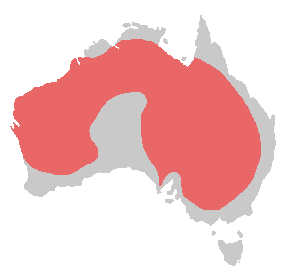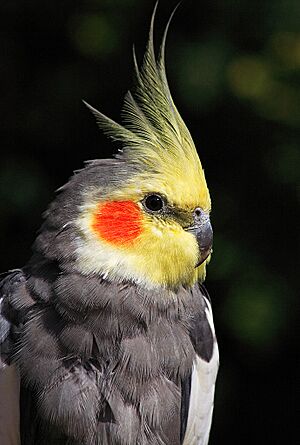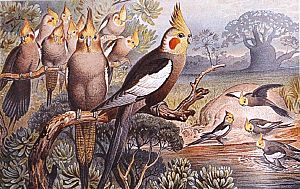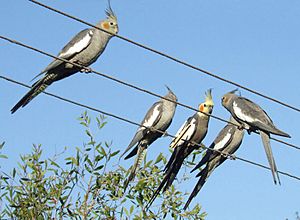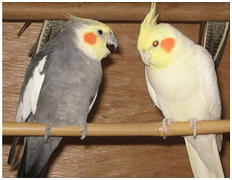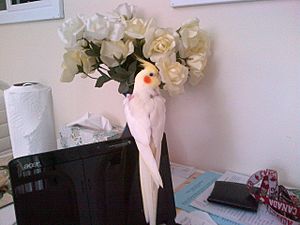Cockatiel facts for kids
Quick facts for kids Cockatiel |
|
|---|---|
 |
|
| Scientific classification | |
| Kingdom: | |
| Phylum: | |
| Class: | |
| Order: | |
| Family: | |
| Subfamily: |
Calyptorhynchinae
|
| Genus: |
Nymphicus
Wagler, 1832
|
| Species: |
N. hollandicus
|
| Binomial name | |
| Nymphicus hollandicus |
|
| Synonyms | |
|
Psittacus hollandicus |
|
The cockatiel (Nymphicus hollandicus) is a popular pet bird. It's also called the quarrion or weiro. This bird is part of the cockatoo family and naturally lives only in Australia. People all over the world love cockatiels as pets because they are friendly and easy to care for. After the budgerigar, cockatiels are the most popular pet birds.
Contents
Where Cockatiels Live
Cockatiels come from Australia. They mostly live in dry or partly dry areas. But they always stay close to water. These birds often move around to find food and water. You usually see them in pairs or small groups. Sometimes, hundreds of cockatiels gather around one water source. Farmers sometimes don't like them because they can eat crops.
Cockatiels are the only cockatoo species that can have babies when they are just one year old.
What Cockatiels Look Like
A cockatiel's special crest on its head shows how it feels.
- If the crest stands straight up, the bird is surprised or excited.
- If it's slightly tilted, the bird is relaxed.
- If it's flat against the head, the bird is angry or trying to protect itself.
- When a cockatiel wants to attract another bird, its crest is flat but sticks out at the back.
- If the bird is tired, the crest is halfway up, and its tip usually curls up.
Unlike most cockatoos, cockatiels have long tail feathers. These feathers make up about half of their total length. Cockatiels are the smallest cockatoos, measuring about 30 to 33 centimeters (12 to 13 inches) long. Most other cockatoos are much bigger, from 30 to 60 centimeters (12 to 24 inches).
The "normal grey" or "wild-type" cockatiel is mostly grey. It has bright white patches on the outer parts of its wings. Male cockatiels have yellow or white faces. Females have grey or light grey faces. Both males and females have a round orange spot on each cheek. These are often called "cheddar cheeks." This orange color is usually very bright in adult males. It is often duller in females. So, you can often tell if a grey cockatiel is male or female just by looking.
Baby cockatiels all have spots under their wings. When they shed their first feathers around 6 months old, the female birds keep their spots. The male birds lose theirs.
Also, adult male cockatiels usually make louder and more varied sounds than females. Cockatiels can learn to sing songs and say many words. They can also copy human or other sounds without being taught.
Cockatiel Colors
There are 22 different cockatiel color mutations that people have bred. Eight of these are only found in Australia. In the wild, cockatiels are grey. Males have yellow heads, and females have grey heads. Young birds look more like females and have pinker beaks.
Here are some popular color changes:
- Pied: This color first appeared in California in 1949. A pied cockatiel has patches of color on an otherwise solid-colored bird. For example, a yellow cockatiel might have grey patches.
- Lutino: First seen in 1958, these birds are white to soft yellow. They don't have the grey color of wild cockatiels. Because of too much inbreeding, many lutino cockatiels have a small bald spot behind their crests.
- Cinnamon: These birds, first seen in the 1950s, look similar to grey cockatiels. But they have a warmer, browner color.
- Pearling: This pattern first appeared in 1967. It looks like a feather of one color with a different colored edge. For example, grey feathers might have yellow tips. This pattern is usually on a bird's wings or back.
- Albino: These birds have no color pigment. They are white with red eyes.
- Fallow: First seen in the 1970s, these cockatiels have cinnamon coloring with yellow parts.
Other colors include emerald/olive, dominant and recessive silver, and special Australian colors like Australian fallow and platinum. There are also mutations that change the face color, like whiteface, pastelface, and yellow cheek.
Cockatiels can even have more than one color mutation at once. For example, a yellow lutino cockatiel might also have pearling. This means it has white spots on its back and wings. This is called a "double mutation." A bird could even have four mutations, like a cinnamon cockatiel with yellowface coloring, pearling, and pied markings.
How Long Cockatiels Live
In captivity, cockatiels usually live for 16 to 25 years. Some reports say they can live as long as 32 years. The oldest confirmed cockatiel lived to be 36 years old!
Images for kids
See also
 In Spanish: Cacatúa ninfa para niños
In Spanish: Cacatúa ninfa para niños


